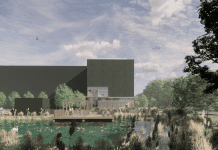There’s no doubt that homes are becoming smarter and more connected to the world of internet-enabled devices, but what does this mean for the planning and construction industries? 1 Click Bathrooms takes a look
The next-generation smart home will change our lives in untold ways, making our current ways of living, where the internet is confined to various devices, a thing of the past.
In this article, we’ll sneak a peek at the latest in smart home technology, and see what these new advances mean for stakeholders all across the planning and construction industries, as well as prospective homeowners.
A revolution in construction
More and more homes these days are being built in using modular construction, wherein components are built offsite and put together onsite – this often results in far less disruption for the local area and a far quicker build time overall.
This modern method of construction has been slowly gaining traction among high-volume housebuilders. Developments such as student accommodation and retirement homes, which require plenty of uniform, modular rooms, were among the first to rediscover this technique, but it is also growing traction within the housebuilding community.
The recently announced Etopia Corby modular village development is a shining example of the future of this kind of housebuilding. The project’s CEO, Joseph Daniels, commented that it is “senseless to cling to bricks and mortar, which takes longer to build and is far more expensive”. You can read more about that development here, doubtless the first of many ‘modular villages’ that will come to define the homes of the future.
Efficiency is paramount
Energy efficiency and eco-friendliness go hand in hand and form the dual purpose that all modern housebuilders should aim for going forward. Everything from grass roofs to rainfall catchers and solar water heaters should be considered when planning a new development, as these additions will not only reduce the carbon footprint but also cut energy bills for residents – a welcome feature in tough economic times.
In-home tech that focuses on efficiency savings, such as a Nest smart thermostat, which challenges residents to reduce the temperature in their home by 1 degree, further improves this from a savings perspective.
Ubiquitous personal assistants
At the moment, personal assistants such as Amazon Alexa and Google Assistant are confined to their respective hardware and other enabled devices. In the home of the future, such virtual assistants will be built into the very fabric of the home, meaning queries, home automation, organisation and more will be accessible from any room.
Of course, this means the house of the future needs to be near-impervious to hacking attempts, which have plagued early adopters in the Internet of Things (IoT) sphere. Housebuilders will have to assuage any fears that their homes’ internet security will be lacking – just in the same way that structural integrity is paramount.
The smart bathroom
At its heart, the smart home revolution is all about making your life easier – whether it’s controlling your home speaker system with your voice or turning your thermostat on just before you get home, everything shares this unified purpose.
The bathroom is no exception. Smart mirrors can give users at-a-glance information in the bathroom, such as email updates and weather readouts – vital for a time-pressed commute that starts in the shower. A smart bathroom can also combine bathroom shower heads with a Bluetooth speaker to make a musical morning in the shower a whole lot easier.
Waterproof TVs are also an option growing in popularity, as consumers will ask, why risk a laptop or tablet near treacherous bathwater when you could have the TV built into the room? Having adequate, waterproof power outlets available for such an addition should be in the minds of luxury housebuilders, as a bathroom TV could be the key element that drives sales in this particular niche.
The smart kitchen
As with the bathroom, a smart kitchen, fully pre-installed in a futuristic home, will help to drive sales in a luxury niche. Again, plenty of power outlets are key to this kind of kitchen succeeding in a new development. The latest in fridge design, pioneered by Silicon Valley startup Innit, can tell when food is about to go off and will suggest recipes and a meal plan, all through push notifications via an app.
Many kitchen appliances already have integration with home assistants such as Alexa, but a fully integrated home will go one further and allow for recipe ideas, real-time stats on how much food is in the fridge and more to be displayed on screens in the kitchen. Samsung’s Family Hub is the benchmark, providing all this and a smart screen to display family photos – a futuristic upgrade to the standard fridge magnet method of displaying postcards.
Making sure there’s enough power and space for these shiny appliances is the bare minimum that housebuilders should be working towards, but a pre-fitted smart kitchen like this will certainly make prospective homeowners believe they’re taking a firm step into the future.
AR/AI: A new horizon
Cutting-edge new technologies such as augmented reality (AR) and artificial intelligence (AI) also find themselves becoming useful niches in the home of the future. AR tech can make homeowners visualise new furniture purchases in their homes, while AI can help home assistants like Alexa or Google Assistant learn about your daily routine – making them more useful as a result.
While one is functional and the other more aesthetically pleasing, these two techs can go hand in hand during the design process. For example, AI can be used to optimise designs by modelling long-term durability, while AR can be used by architects to physically visualise what a new home development might look like in a particular area, and what can fit in various rooms to maximise ergonomic flow.
1 Click Bathrooms
https://1clickbathrooms.co.uk/
Twitter: @1clickbathrooms

















